The Spiritual Birthplace of the Ahmadiyya Muslim Community
Qadian is a town and a municipal council in Gurdaspur District, north-east of Amritsar, situated 18 kilometres north-east of Batala city in the state of Punjab, India.
Being the birthplace of Hazrat Mirza Ghulam Ahmadas, the Holy Founder of the Ahmadiyya Muslim Community, and the place where he spent his entire life and where his tomb is situated, Qadian holds a great spiritual and historical significance for the Ahmadiyya Muslim Community.
The foundations of Qadian were raised in 1530 during the reign of Mughal Emperor Babar, when Mirza Hadi Beg, a chief of Barlas Mughals coming from Samarqand, entered India with his family and 200 companions. After a sojourn in Delhi, he settled in the uninhabited and desolate area of Majha in Punjab, about 70 miles North-East of Lahore. He was appointed as Qazi over a jurisdiction covering about 200 villages. Over the centuries which followed, the name of the town changed from Majha (related to Majh meaning buffalo) to Islampur, to Islampur Qazi Majhi, to Qazi Majhi, to Qazi, and finally to Qadian – a town of Qazis i.e. legalists or jurists.
The town served as the capital of about 200 villages. Over time, the ministate weakened and was reduced to 80-85 villages under its jurisdiction by the time of Mirza Gul Muhammad, the great grandfather of Hazrat Mirza Ghulam Ahmad, the Promised Messiahas.
Later on, Ramgarhia Sikhs occupied the town in 1802, and the family of the founders of the town was evicted of the town and sought refuge in a state in Punjab. Some time after 1816, Maharaja Ranjit Singh defeated Ramgarhias and occupied the area. In the period between 1833 and 1835, he gave back the region consisting of Qadian and some adjoining villages to Mirza Ghulam Murtaza, the father of the Promised Messiahas.
Prophesying the advent of the Promised Messiah who was to appear in the Muslim Ummah in the latter days, the Holy Prophetsa mentioned the name of this town in one of his narrations:
Mahdi will rise from a town which will be called Kad’ah
Jawahir al-Asrar p. 55
This prophecy came true. The Holy Founder of the Ahmadiyya Muslim Community, Hazrat Mirza Ghulam Ahmadas, who claimed to be the Promised Messiah and Imam Mahdi was born in Qadian. Being his birthplace and hometown, Qadian possesses an extraordinary spiritual significance which attracts people from all around the globe every year.
For Ahmadis, it is the place where the promised renaissance of Islam occurred in accordance with the prophecy of the Holy Prophetsa. In this sense, Qadian holds exceptional importance for Ahmadi Muslims who consider it sacred after the two holiest cities of Mecca and Medina.
So far as my claim is concerned, there are so many signs and arguments in my support that unless a person is an errant knave, he shall have no alternative but to believe in me exactly as he believes in the Holy Prophet, on whom be peace.... The traditions even mention the name of my village in the word ‘Kad’ah’
Qadian remained the administrative headquarters of the Ahmadiyya Muslim Community until the partition of India in 1947. As the events unfolded, the then-Caliph of the Community along with most Ahmadis in the Northern part of India were forced to migrate to Pakistan thereby moving the Community’s headquarters to a town called Rabwah in the newly founded state. Later in 1984, the Fourth Caliph of the Ahmadiyya Muslim Community migrated to England moving the Community’s Headquarters to London. Currently, the Community is headquartered in Islamabad, Tilford, UK. Qadian now serves as the national headquarters of the Community in India.
Nevertheless, being the spiritual birthplace of Ahmadiyyat, Qadian holds special significance beyond its administrative status and is frequently visited by Ahmadis and others from across the world. Ahmadis visit its holy sites where the Promised Messiahas spent every moment of his life in worship and remembrance of the Almighty and in service of Islam.
Prophets are the greatest signs of God. It is through them that the true image of God is established in people’s hearts. Their very persons act as a mirror that manifests the glory and majesty of the Almighty. At their hands occur great signs that prove the existence of God beyond doubt. Hence, although they are not Divine themselves, their persons, by virtue, are sacred as they are the bridge that connects man with his Creator. This sacredness, which is innate in their persons is radiated into their surroundings – in the paths they walked on, the structures they dwelled in and the things they came into contact with. Hence, these things then act as faith-inspiring elements for the believers. This is the reason that the cities where prophets lived are considered holy by their followers.
In this sense, Ahmadi Muslims have the utmost reverence for the holy cities of Mecca and Medina for being the places that were blessed with the presence of the Holy Prophet Muhammadsa. Similarly, Qadian being the birthplace of the Promised Messiahas who was a prophet subservient to the Holy Prophetsa, it is considered sacred by Ahmadi Muslims. Though the whole town was blessed by the presence of the Promised Messiahas, some holy sites possess extraordinary importance for their historical and spiritual background. Some of those sacred sites are the following:
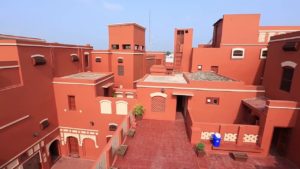
Darul Masih is the residence of the Promised Messiahas. It comprises the room where the Promised Messiahas was born, the room where his promised son was born, the room where he observed fast for six months, among many other areas of historical significance.
The structure of Darul Masih was built with high-quality bricks and materials, and still stands mostly in its original shape and condition, except for minor upgrades. A large part of the early history of the Ahmadiyya Muslim Community, the trials and tribulations, and the memories of the moments of joy and jubilations revolves around this structure.
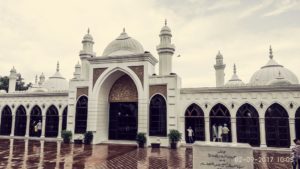
Masjid Aqsa (not to be confused with Al-Masjid al-Aqsa of Jerusalem) is a mosque in Qadian. The mosque was built by Hazrat Mirza Ghulam Murtaza, father of Hazrat Mirza Ghulam Ahmadas, in 1876.
The mosque had been renovated and extended many times, and the capacity of the building increased from its initial capacity of 200 to 15,000 by the year 2014.
The mosque is situated inside the compound of the family house of Hazrat Mirza Ghulam Ahmadas. The mosque also serves as a venue for various religious meetings and events.
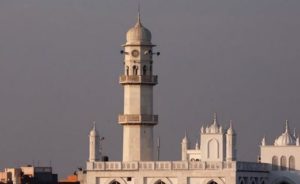
Minaret-ul-Masih – meaning the Minaret of the Messiah – is a stone tower and monument standing beside Masjid Aqsa.
One of the signs of the advent of the Promised Messiah as described by the Holy Prophetsa was that he will be raised near a white minaret east of Damascus.
Although the real meaning of the minaret is symbolic, it was the practice of Hazrat Mirza Ghulam Ahmadas to endeavour to fulfil every prophecy in its literal form as well. For this reason and under divine instructions he laid the foundation stone of this minaret on Friday 13 March 1903. However, due to lack of funds, the work could not be completed in his lifetime.
It was resumed by the Second Caliph of the Community, Hazrat Mirza Bashiruddin Mahmud Ahmadra, by laying a brick again on 27 November 1914. The structure was completed in early 1916. In 1938-39, the minaret was coated with plaster of white marble.
It was veneered with white marble slabs in 1980-81 during the time of the Third Caliph, Hazrat Mirza Nasir Ahmadrh.
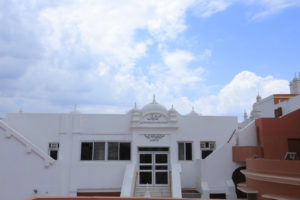
Under the Divine Command of God, in around 1882-1883, the Promised Messiahas laid the foundation stone of the Masjid Mubarak in Qadian.
Upon laying the historic foundation of this mosque, he received several revelations, one of which was as follows:
مُبَارِكٌ وَّ مُبَارَكٌ وَّ كُلُّ اَمْرٍ مُّبَارَكٍ يُّجْعَلُ فِيْهِ
This mosque is a source of blessings, is blessed itself, and every blessed deed will be performed in it.
Remarkably, when the numerical value assigned to each of the letters present in the revelation is considered into a total figure, the number attained is 1300. The Mubarak Mosque was completed, in the Islamic Calendar, on 26 Shawal in the year 1300.
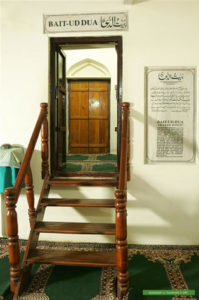 Attached to Masjid Mubarak, a room was prepared by the Promised Messiahas on 13 March 1903. He got this room made for solitary supplications and named it Baitud Dua – meaning ‘the room of supplications’. He prayed for it to be a place of peace, harmony, and a source of victorious arguments in favour of Islam.
Attached to Masjid Mubarak, a room was prepared by the Promised Messiahas on 13 March 1903. He got this room made for solitary supplications and named it Baitud Dua – meaning ‘the room of supplications’. He prayed for it to be a place of peace, harmony, and a source of victorious arguments in favour of Islam.
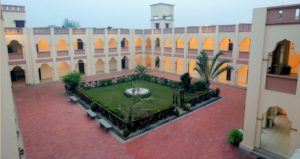
Langar Khana, also known as Darul-Ziyafat, was started by the Promised Messiahas. It cares for visitors and seekers after truth – both Ahmadis and non-Ahmadis – who come to Qadian. Adequate arrangements for board and lodging for such persons exist in the Langar Khāna.
Describing the five branches for the propagation of Islam in his book, Fath-e-Islam, the Promised Messiahas writes about the third branch as follows:
The third branch of this movement is those people who travel and visit in search of truth and other different reasons, and those who after getting the news of this Heavenly movement come to meet me. This branch is also continuously developing. Although on some days less, but on the other days a large number of people start coming. For example, during the past seven years, slightly more than 60,000 guests may have come.
It was to provide accommodation and free hospitality to these guests that Langar Khana was established by the Promised Messiahas.
Today, while the Community has widely spread throughout the world, most of its missions established also have a small community kitchen that hosts the guests of the community.
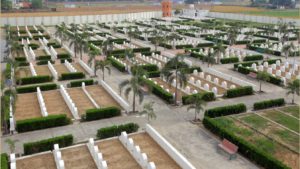
Bahishti Maqbara – meaning the Heavenly Graveyard – is the burial site of the Promised Messiahas.
At the end of 1905, the Promised Messiahas started receiving revelations indicating that his demise was near. Hence, he published a will entitled, Al-Wasiyyat and also published all of the revelations about his demise.
In this will, the Promised Messiahas, under Divine guidance, also proposed the establishment of a special graveyard, which he named Bahishti Maqbara. The idea of Bahishti Maqbara was, in fact, based on a dream seen by the Promised Messiahas several years before this, in which God Almighty had told him to establish a separate graveyard for the especially sincere and righteous people of the Community, who are blessed in the sight of God.
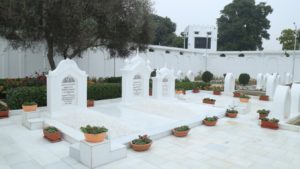
In this way, seeing all pious souls together would act as a source of rejuvenation of faith for the coming generations whenever they visit this graveyard.
The funeral prayer of the Promised Messiahas took place on the grounds of Bahishti Maqbara and he was buried here. Many of the companions of the Promised Messiahas as well as others are buried and continue to be buried in this Heavenly Graveyard.

Darul Masih is the residence of the Promised Messiahas. It comprises the room where the Promised Messiahas was born, the room where his promised son was born, the room where he observed fast for six months, among many other areas of historical significance.
The structure of Darul Masih was built with high-quality bricks and materials, and still stands mostly in its original shape and condition, except for minor upgrades. A large part of the early history of the Ahmadiyya Muslim Community, the trials and tribulations, and the memories of the moments of joy and jubilations revolves around this structure.

Masjid Aqsa (not to be confused with Al-Masjid al-Aqsa of Jerusalem) is a mosque in Qadian. The mosque was built by Hazrat Mirza Ghulam Murtaza, father of Hazrat Mirza Ghulam Ahmadas, in 1876.
The mosque had been renovated and extended many times, and the capacity of the building increased from its initial capacity of 200 to 15,000 by the year 2014.
The mosque is situated inside the compound of the family house of Hazrat Mirza Ghulam Ahmadas. The mosque also serves as a venue for various religious meetings and events.

Minaret-ul-Masih – meaning the Minaret of the Messiah – is a stone tower and monument standing beside Masjid Aqsa.
One of the signs of the advent of the Promised Messiah as described by the Holy Prophetsa was that he will be raised near a white minaret east of Damascus.
Although the real meaning of the minaret is symbolic, it was the practice of Hazrat Mirza Ghulam Ahmadas to endeavour to fulfil every prophecy in its literal form as well. For this reason and under divine instructions he laid the foundation stone of this minaret on Friday 13 March 1903. However, due to lack of funds, the work could not be completed in his lifetime.
It was resumed by the Second Caliph of the Community, Hazrat Mirza Bashiruddin Mahmud Ahmadra, by laying a brick again on 27 November 1914. The structure was completed in early 1916. In 1938-39, the minaret was coated with plaster of white marble.
It was veneered with white marble slabs in 1980-81 during the time of the Third Caliph, Hazrat Mirza Nasir Ahmadrh.

Under the Divine Command of God, in around 1882-1883, the Promised Messiahas laid the foundation stone of the Masjid Mubarak in Qadian.
Upon laying the historic foundation of this mosque, he received several revelations, one of which was as follows:
مُبَارِكٌ وَّ مُبَارَكٌ وَّ كُلُّ اَمْرٍ مُّبَارَكٍ يُّجْعَلُ فِيْهِ
This mosque is a source of blessings, is blessed itself, and every blessed deed will be performed in it.
Remarkably, when the numerical value assigned to each of the letters present in the revelation is considered into a total figure, the number attained is 1300. The Mubarak Mosque was completed, in the Islamic Calendar, on 26 Shawal in the year 1300.
 Attached to Masjid Mubarak, a room was prepared by the Promised Messiahas on 13 March 1903. He got this room made for solitary supplications and named it Baitud Dua – meaning ‘the room of supplications’. He prayed for it to be a place of peace, harmony, and a source of victorious arguments in favour of Islam.
Attached to Masjid Mubarak, a room was prepared by the Promised Messiahas on 13 March 1903. He got this room made for solitary supplications and named it Baitud Dua – meaning ‘the room of supplications’. He prayed for it to be a place of peace, harmony, and a source of victorious arguments in favour of Islam.

Langar Khana, also known as Darul-Ziyafat, was started by the Promised Messiahas. It cares for visitors and seekers after truth – both Ahmadis and non-Ahmadis – who come to Qadian. Adequate arrangements for board and lodging for such persons exist in the Langar Khāna.
Describing the five branches for the propagation of Islam in his book, Fath-e-Islam, the Promised Messiahas writes about the third branch as follows:
The third branch of this movement is those people who travel and visit in search of truth and other different reasons, and those who after getting the news of this Heavenly movement come to meet me. This branch is also continuously developing. Although on some days less, but on the other days a large number of people start coming. For example, during the past seven years, slightly more than 60,000 guests may have come.
It was to provide accommodation and free hospitality to these guests that Langar Khana was established by the Promised Messiahas.
Today, while the Community has widely spread throughout the world, most of its missions established also have a small community kitchen that hosts the guests of the community.

Bahishti Maqbara – meaning the Heavenly Graveyard – is the burial site of the Promised Messiahas.
At the end of 1905, the Promised Messiahas started receiving revelations indicating that his demise was near. Hence, he published a will entitled, Al-Wasiyyat and also published all of the revelations about his demise.
In this will, the Promised Messiahas, under Divine guidance, also proposed the establishment of a special graveyard, which he named Bahishti Maqbara. The idea of Bahishti Maqbara was, in fact, based on a dream seen by the Promised Messiahas several years before this, in which God Almighty had told him to establish a separate graveyard for the especially sincere and righteous people of the Community, who are blessed in the sight of God.

In this way, seeing all pious souls together would act as a source of rejuvenation of faith for the coming generations whenever they visit this graveyard.
The funeral prayer of the Promised Messiahas took place on the grounds of Bahishti Maqbara and he was buried here. Many of the companions of the Promised Messiahas as well as others are buried and continue to be buried in this Heavenly Graveyard.
© 2021 All rights reserved